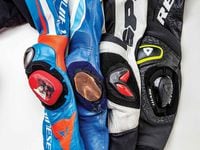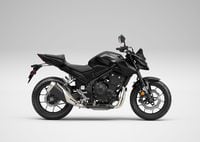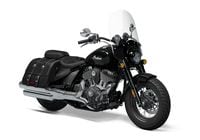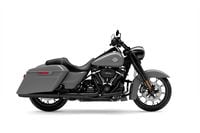Roadracers have been scraping tarmac with their knees since the 1970s. American racing legend Kenny Roberts Sr. popularized a new style of riding introduced by Finnish rider Jarno Saarinen, which saw riders lowering their body position and regularly skimming their knees on the ground—on purpose. The result? Faster lap times, bloody limbs, and torn leathers.
In those days, most riders layered the knees of their suits with duct tape, adding extra protection and helping their knees glide along the asphalt. Others were more creative, carefully dissecting plastic milk cartons. It wasn’t until the ’80s that leather manufacturers adopted dedicated knee sliders mounted to the suit via Velcro, like the ones we still see today. Some wood, others leather, and most plastic, these were the first means of purpose-built pucks, and the end of non-incidental road rash.
Steeper lean angles and evolution in riding technique have since added purpose to the role of knee sliders, with racers using the pucks as a feeler gauge on the track. Touching sliders to the asphalt comes with a boost of confidence, providing riders exactness in their perception of lean angles, especially on a wet racetrack. Like tires, knee pucks require a break-in process before they’re optimal. The asphalt carves into the slider, precisely matching the rider’s angle of attack, perfecting the feel as they drag their bodies through corners.
Sliders can also prove vital in saving racers from hitting the deck. Ask MotoGP rider Marc Marquez—a man known for saving crashes on his knee. The seven-time world champion chews through tens of Alpinestars proprietary plastic sliders each year, replacing them nearly every time he exits the pit lane. Imagine how his knees would look in the duct-tape days.


/cloudfront-us-east-1.images.arcpublishing.com/octane/WCJVB43G7VAC5N5UCBTFJXT6DA.jpg)
/cloudfront-us-east-1.images.arcpublishing.com/octane/GJZAJUJPHZDFPIOZUXFPTTZGGY.jpg)
/cloudfront-us-east-1.images.arcpublishing.com/octane/MMPNVEHLM5GYPECTODIKYKDJVU.jpg)
/cloudfront-us-east-1.images.arcpublishing.com/octane/BHSBSOJ5IFENROCJTGDDW37JPY.jpg)


/cloudfront-us-east-1.images.arcpublishing.com/octane/FJKCDM4N6BDTDCOE4CQFSS6VQE.jpg)
/cloudfront-us-east-1.images.arcpublishing.com/octane/ZL5XFWNFJVGP3BUH245QOW4OPU.jpg)
/cloudfront-us-east-1.images.arcpublishing.com/octane/AP2OUFOAQBE3VP5TXTBNXM57PU.jpg)
/cloudfront-us-east-1.images.arcpublishing.com/octane/6TBJOYAXHRD7LEXKXVSZFESQRE.jpg)
/cloudfront-us-east-1.images.arcpublishing.com/octane/NA6GARIGNNBRRMWPCGLW7GMIPU.jpg)
/cloudfront-us-east-1.images.arcpublishing.com/octane/PFP7LTPXMZGM3P5MUQ55CRLGDQ.jpg)
/cloudfront-us-east-1.images.arcpublishing.com/octane/AANFFQ76NZHGZI32JHYLZWECZE.jpg)


/cloudfront-us-east-1.images.arcpublishing.com/octane/HV4KF6WQSRB7XI4BIXC3RAJQFQ.jpg)
/cloudfront-us-east-1.images.arcpublishing.com/octane/OJJBMZMGB5ESVDMU7JP3DLGRNA.jpg)
/cloudfront-us-east-1.images.arcpublishing.com/octane/LKJGT7AQWNCKROINJHQZJINOLQ.jpg)
/cloudfront-us-east-1.images.arcpublishing.com/octane/C7JXP6I6HZD27NKSD5DN7W4P6M.jpg)

/cloudfront-us-east-1.images.arcpublishing.com/octane/TBWVGMFVFNE5RBQHGL3S5P6D3Q.jpg)
/cloudfront-us-east-1.images.arcpublishing.com/octane/P2LSTY5BCFBZLJGGNI4DEVDO7M.jpg)
/cloudfront-us-east-1.images.arcpublishing.com/octane/SNXNG3GGIFECLOVO4BNRRWGSOU.jpg)